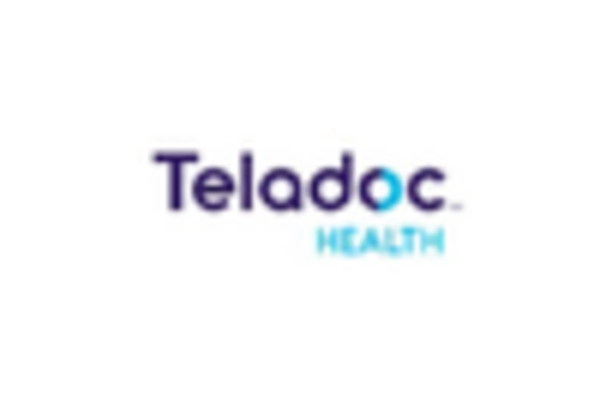Expansion of Insurance Coverage
The expansion of insurance coverage for telehealth services is a significant driver for the telerehabilitation market. In recent years, many insurance providers have begun to recognize the value of remote rehabilitation services, leading to broader coverage options for patients. This trend is supported by legislative changes at both state and federal levels, which have aimed to increase access to telehealth services. As of November 2025, approximately 80% of private insurers in the US offer some form of coverage for telerehabilitation, reflecting a growing acceptance of these services. This increased insurance support not only alleviates financial burdens for patients but also encourages healthcare providers to adopt telerehabilitation practices. Consequently, the telerehabilitation market is expected to expand as more patients gain access to these essential services.
Cost-Effectiveness of Remote Services
Cost considerations play a significant role in the expansion of the telerehabilitation market. Traditional rehabilitation services often incur high costs due to travel, facility fees, and time away from work. Telerehabilitation offers a more cost-effective alternative, reducing overhead expenses for healthcare providers and patients alike. A study by the American Physical Therapy Association indicates that telerehabilitation can lower costs by up to 30% compared to conventional methods. This financial advantage is particularly appealing to insurance companies and healthcare systems, which are increasingly looking for ways to optimize spending while maintaining quality care. As cost pressures continue to mount in the healthcare sector, the telerehabilitation market is likely to benefit from this shift towards more economical treatment options.
Rising Prevalence of Chronic Conditions
The increasing prevalence of chronic conditions in the US is a pivotal driver for the telerehabilitation market. Conditions such as diabetes, cardiovascular diseases, and musculoskeletal disorders necessitate ongoing rehabilitation services. According to the Centers for Disease Control and Prevention (CDC), approximately 60% of adults in the US live with at least one chronic condition. This growing patient population requires accessible rehabilitation solutions, which telerehabilitation can provide. The convenience of remote therapy sessions allows patients to engage in their rehabilitation programs without the need for frequent in-person visits, thereby enhancing adherence to treatment plans. As the demand for effective management of chronic conditions rises, the telerehabilitation market is poised for substantial growth, potentially reaching a valuation of $5 billion by 2027.
Technological Integration in Healthcare
The integration of advanced technologies into healthcare systems is a crucial driver for the telerehabilitation market. Innovations such as wearable devices, mobile health applications, and virtual reality are enhancing the delivery of rehabilitation services. These technologies facilitate real-time monitoring of patient progress and enable personalized treatment plans. The US healthcare system is increasingly adopting these technologies, with a reported 40% of healthcare providers utilizing telehealth solutions as of 2025. This trend not only improves patient engagement but also allows for more effective tracking of rehabilitation outcomes. As healthcare providers continue to embrace technological advancements, the telerehabilitation market is expected to experience significant growth, potentially transforming the landscape of rehabilitation services.
Increased Focus on Patient-Centered Care
The shift towards patient-centered care is reshaping the telerehabilitation market. Healthcare providers are increasingly prioritizing patient preferences and needs, leading to a demand for more flexible and accessible rehabilitation options. Telerehabilitation aligns with this trend by offering patients the ability to participate in their recovery from the comfort of their homes. This approach not only enhances patient satisfaction but also improves adherence to rehabilitation protocols. According to a survey conducted by the National Institutes of Health, 75% of patients expressed a preference for remote rehabilitation services over traditional in-person visits. As the healthcare landscape continues to evolve towards a more patient-centric model, the telerehabilitation market is likely to thrive, catering to the growing expectations of patients.

















Leave a Comment